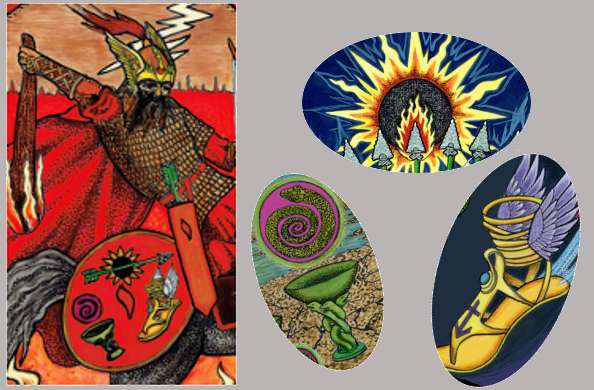The ultimate user guide for understanding how to read and use the court cards of tarot
Tarot court cards often confuse people in readings. They often are not sure how to read tarot court cards, or which one to choose as a significator card. So it is important to understand “Who are all these people?”
And what about when the tarot court cards seem to be referring to a situation, rather than a person?
Tarot court cards: Who – or what – do they mean?
“Who does this tarot court card represent? What does the Knight of Wands mean in a tarot reading? How do I choose a tarot significator card and which tarot card am I?” Those are questions that often come up when a court card appears in a reading, or when using the court cards to choose a tarot significator card.
- At the beginning of this article, we will go over some helpful basics about choosing and using tarot significator cards and understanding the tarot court cards. At the end we provide the summarized meanings of each tarot court card in a reading, or for use in choosing a tarot card significator.
Generally speaking, the tarot court cards represent various types of people in all their complexity. In some cases, they can refer to aspects of the self or the querent that are manifesting in a certain circumstance. They can also represent a situation. For example, when the Princess or Page of Disks appears, it can sometimes signify something material is completed, or something is coming to fruition. Want to know how to read the tarot court cards when they don’t seem to be referring to a person? We will cover that too!
What is a tarot significator card?
What is a tarot significator card? It is a card that is used as a focus point and stand in for the querent (the person asking a question of a tarot reading). If reading for yourself, that’s you. Or if reading for another, then the significator represents them. Alternatively, some use non-court card significators to represent situations they are inquiring about. But this article focuses on the more common use of the tarot court cards as representing querents, and representing relevant people who show up in a tarot reading.
Why to choose a tarot significator card
Why choose a significator card for your tarot reading? As stated, the purpose of a significator is to enhance focus, and energetically align the reading with the person being read for. By placing a significator as the focal point, it places the querent as fully present on the plane of the reading, affected by and interacting with the symbolism of the other cards. It can be considered a magical stand-in for the person, allowing the mind to aim attention at the issues of the reading from the perspective of the querent. For this reason, a tarot significator is also used when performing ritual magic with tarot.
Appearances of the tarot court cards
Many antiquated and outmoded tarot texts base this choice on appearances. For example, that a certain court card represents something like “a fair man with blue eyes”. While you might have a person that fits that description, this obviously is too restrictive. This often doesn’t work in our modern and diverse world. It also tells you nothing about who the person is and how you experience them.
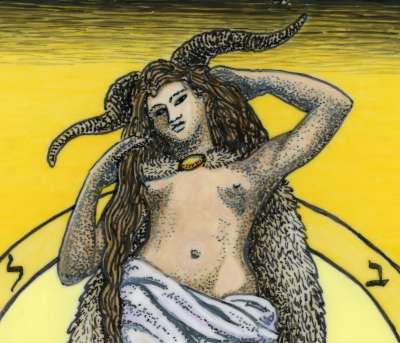
Don’t get hung up on tarot court cards appearances; learn their personalities
Though they are of limited use, the hair and eye color descriptions can be used for visualization or additional information. Or if you are just curious about the traditional appearances of the tarot court cards, here is a list of the hair and eye colors traditionally attributed.
- Knight of Wands aka King of Wands: Red-gold hair, Grey or Hazel eyes
- Queen of Wands: Red-gold hair, Blue or Brown eyes
- Prince of Wands aka Knight of Wands (RWS): Yellow hair, Blue Grey eyes
- Princess of Wands: Red-gold hair, Blue eyes
- Knight of Cups aka King of Cups: Fair hair, Blue eyes
- Queen of Cups: Gold-brown hair, Blue eyes
- Prince of Cups aka Knight of Cups (RWS): Brown hair, Grey or Brown eyes
- Princess of Cups: Brown hair, Blue or Brown eyes
- Knight of Swords aka King of Swords: Dark brown hair, Dark eyes
- Queen of Swords: Grey hair, Light Brown eyes
- Prince of Swords: Grey hair, Dark eyes
- Princess of Swords: Light Brown hair, Blue eyes
- Knight of Disks aka King of Pentacles: Dark hair, Dark eyes
- Queen of Disks or Pentacles: Dark hair, Dark eyes
- Prince of Disks aka Knight of Pentacles (RWS): Dark Brown hair, Dark eyes
- Princess of Disks aka Page of Pentacles: Rich Brown, Dark eyes
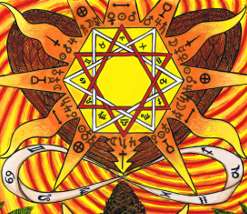
Tarot court cards and astrological signs
One can also choose a tarot signifcator or identify who a court card represents in a tarot reading based on astrological Sun signs, or the Ascendant sign. While this can be more appropriate than going by appearances only, sometimes it just doesn’t quite fit the querent or subject for one reason or another.
While most people know their own astrology chart or at least their Sun sign, they don’t know the astrological factors of everyone they know or may meet. Someone may be a Libra Sun sign – but have Moon, rising, and a stellium of planets in Scorpio and be better described by a Scorpio court card. For reasons such as these, using Sun sign astrology to identify who is represented by a tarot court card isn’t always the best way either.
Reading and choosing tarot court cards: personality traits
Because the querent generally has an emotional investment in the outcome of the reading, the best way to choose a significator is usually based on the personality traits associated with each court card. This is a better way to choose a card that energetically resonates with the questioner.
Likewise, when a court card shows up in a tarot reading, while sometimes appearances or astrological sun signs apply, more often they describe a person who shares certain character traits with the court card. They describe a person in your life who has these personality traits. Or at least one that you experience in a certain way. People are complex and contain multitudes, and are constantly morphing and changing as they evolve. They may just be displaying these character traits in the situation in question. As always, tarot reading is an art, and context is important.
Tarot court cards age and gender considerations, rank, and Qabalistic order
In general, though there are exceptions, the court cards most usually are at least somewhat defined by age and gender identity. Both of these can be subjective.
The rank of the tarot court cards King-Queen-Prince-Princess is in accordance with the Qabalistic formula of the Tetragrammaton. Tetragrammaton refers to the four-fold divine name YHVH, Yod–Heh–Vav–Heh. This also corresponds to the order of the elements, Fire-Water-Air-Earth, and the four Qabalistic worlds Atziluth–Briah–Yetzirah–Assiah.
Yod corresponds to the King or Father (the Knights in Thoth based decks). The first or primal Heh is the Queen or Mother. Vav corresponds to the Son, or Prince (which confusingly, are called Knights in RWS decks). The final Heh represents the Daughter, or Princess (Page in RWS based decks). Though Prince and Princess are both children of the King and Queen, it is understood that the Prince is first born in the lineage. Therefore Princesses or Pages are often younger types.
On the Tree of Life, Kings correspond to the sephira Chokmah, Queens to Binah, Princes to Tiphareth, and Princesses to Malkuth.
Tarot court cards age gender generalizations
The Knights in Thoth based decks (Kings in Rider Waite based decks) represent men, either older men or men of some significance coming from a place of power. The Queens represent mature women and women with authority. The Princes in Thoth based decks (Knights in Rider Waite based decks) are usually younger adult men. they may also be men with youthful qualities, or a male youth.
Princesses in Thoth based or Thoth inspired decks (Pages in Rider Waite based decks) are usually young women, teenage girls, or female children. When adult women are represented by a Princess card they signify the elemental type of woman, who is expressing the suit element very intensely. Pages can also represent very young children of either sex, usually those who are not yet fully psychologically concretized.
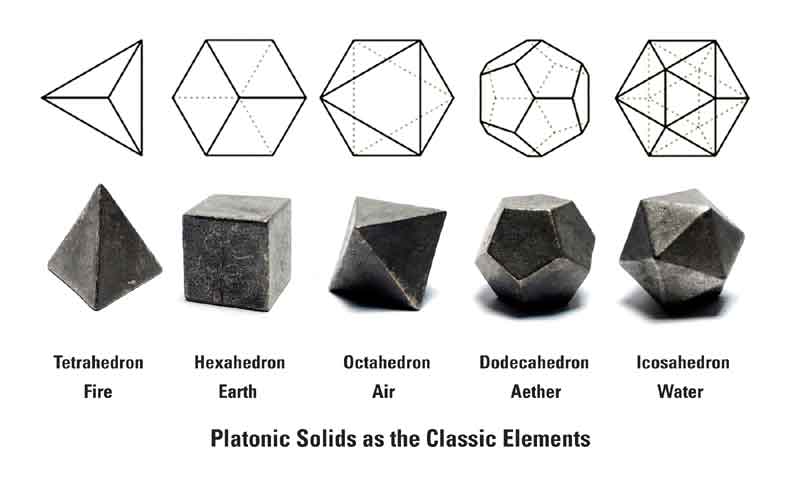
Tarot court cards and the elements
Every court card has the element of its suit as part of its nature, but combines that with the element of its rank. The suit element is the foundation, while the rank element is an expressive part of, or an influence on, that foundation.
Elementally, Wands are Fire, Cups are Water, Swords are Air, and Disks are Earth.
The rank of King corresponds to Fire, Queen to Water, Prince to Air, and Princess to Earth.
When we speak of the elements however, we are not talking about the actual material substances manifest here in the mundane world. We are considering their qualities as representative of certain actions.
- Fire signifies Will and Force, pure and consuming, it is an outwardly projecting explosive force that lets nothing stand in its way.
- Water takes on the form of its container. It takes things in and is receptive and reflective, sensitive and intuitive. With Water we have emotional considerations.
- Air is expressive, where we form and articulate thought. It is inconstant and always moving and changing. Air qualities are intellectual, rational, perceptive, and articulate.
- Earth represents solid physical things of the material world: the body, and its available resources. Its qualities are heavy, patient, and enduring.
Will-Love-Reason-Action in the tarot court cards
These factors can be summarized as Will (Fire) – Love (Water) – Reason (Air) – Action (Earth). They combine in various ways in the court cards, according to the element of the suit as expressed through rank. For example, the Queen of Wands is “Water of Fire”: Water because she is a Queen, but Fire because her suit is Wands. She is definitely a fire card! That is her foundational element. Yet she is also watery in that she expresses a watery expression of Fire. Her fire is inwardly directed and contained, as opposed to the outwardly explosive nature of her counterpart, the King of Wands who is Fire of Fire.
Will is associated with creativity, force, and passion. Love can also be expressed as devotion. Reason is just another way of saying planning, decision making, and thinking. Action also means embodiment and manifesting.
Another way of expressing the qualities of the court hierarchy King-Queen-Prince-Princess is “Forge on”, “Steady devotion”, “Progress from the heart”, and “embody and establish”.
Tarot court cards and the astrological decans
A very useful thing to consider when reading the court cards and understanding their personalities has to do with astrological decans and their associated minor arcana. Kings, Queens, and Princes each oversee a three-decan segment of the zodiac. Two of their decans will correspond to their element and primary zodiac sign. But they also pick up the last decan of the preceding sign, often referred to as their “shadow” decan.
Each of those three decans related to a court card corresponds to a tarot card of the minor arcana. The two primary decans that match their element will be at the forefront of their personality. But their “shadow” decan trails along with them too, and reveals more hidden facets of the personality. Tabula Mundi Tarot is a great choice if you would like to understand the nature of the court cards. As an assistance to your reading the courts, each contains visual elements of their related minor cards encoded in the art as a mnemonic trigger.
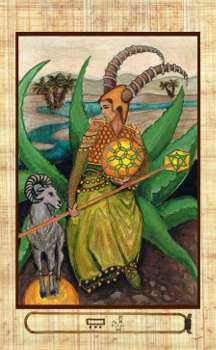
The Queen of Disks aka Queen of Pentacles and her decans
For example, the Queen of Disks (or Queen of Pentacles) is Water of Earth. Water as she is a Queen and Earth because Disks (and Pentacles) correspond to the Earth element. It’s an Earth card, not a Water card, but as Water of Earth she represents its fecundity: the ability to grow and build material things.
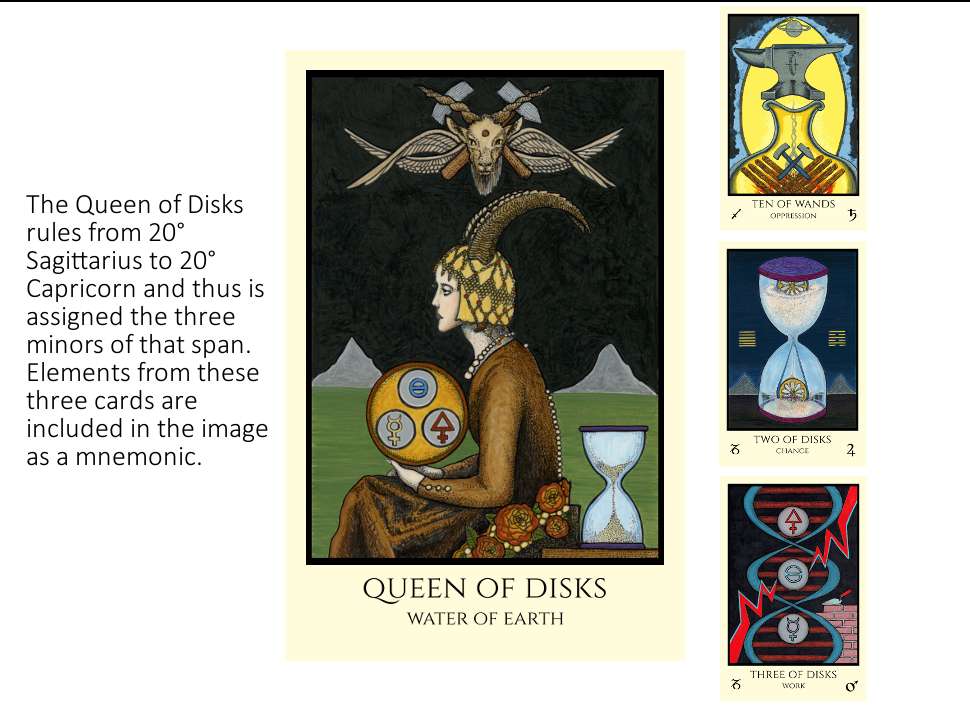
Look at the Tabula Mundi Tarot’s Queen of Disks card in the above diagram. See that she has the hourglass symbol from the Two of Disks. The disk she carries has the three alchemical emblems from the Three of Disks card. The Two of Disks, Harmonious Change brings material growth through a cycle of expansion and contraction over time. The Three of Disks, Work or Works, represents her ability to use the building blocks at her disposal in order to create. The Two of Disks and Three of Disks are both Capricorn cards, and Capricorn is an Earth sign. This is her primary sign and element.
But she also picks up the last decan of the previous sign, the fire sign Sagittarius. this gives her the Ten of Wands as a “shadow”. We see in the crest above her the hammer and pick of the Ten of Wands, Oppression. This reminds us that she also can have an overbearing or even despotic part of her nature.
The astrological modalities of the tarot court cards
The astrological modalities are the qualities of Cardinal, Fixed, and Mutable. The four seasons of the year each comprise three signs, one of each modality. Cardinal signs begin the season, fixed signs occur at its height, and mutable signs begin to usher in the change of season.
- Cardinal signs (Aries, Cancer, Libra, Capricorn) are the controlling types who initiate.
- Fixed signs (Taurus, Leo, Scorpio, Aquarius) are single-minded and unchanging.
- Mutable signs (Gemini, Virgo, Sagittarius, Pisces) are adaptable and flexible.
These of course are generalizations. But they may yield a little insight into the psychology of the court card ranks based on the sign of their main and shadow decan influences.
- Knights in the Thoth deck (Kings in the RWS deck) are generally considered mutable. Two of their three decans are a mutable sign and their shadow decan is a fixed sign.
- Queens are considered cardinal, with two decans in a cardinal sign and one mutable sign shadow decan.
- Princes are considered fixed, with two decans in a fixed sign and a shadow decan in a cardinal sign.
- Princesses have entire quadrants of three complete signs, one of each modality.
The Three Gunas of Vedic Philosophy and tarot court cards
It gets interesting when you also consider the three alchemical types (Sulphur, Mercury, Salt) and the “Three Gunas” Rajas, Sattva, and Tamas of Vedic philosophy. The Gunas are divisions of Prakriti – Sanskrit for “Nature”. Knights are considered Cardinal, Sulphuric, and Rajasic in nature – yet they have two Mutable decans and one Fixed decan. Queens are considered Fixed, Salty, and Tamasic – yet have two Cardinal decans and one Mutable decan. Princes are considered Mutable, Mercurial, and Sattvic in nature, yet have two Fixed decans and one Cardinal decan.
At first glance this may be perplexing, but it truly illustrates the complex nature of people. We contain multitudes! And, with some thought, it actually works.
It is the duty of the elements to mix
Consider for example the Knights – they are the Fire rank which is Sulphuric and Rajasic. In Thoth based decks they charge forward on horses. Their Cardinal nature shows in that they indeed rush in and initiate forceful action. Yet two of their decans are a Mutable sign – their influence is changeable and not long lasting. Their Fixed sign shadow decan may show an area where they get stuck in rigid patterns.
Looking at the Queens, they are poised on thrones of authority, receptive, placid, and steady which is considered a Fixed, Salty or Tamasic quality. Yet one cannot doubt that Queens also exhibit Cardinal qualities of control and command, matching their main two decans. Their Mutable shadow decan shows an area where their strength wavers.
Princes are on Chariots: combining the traits of the royal parents, they are on movable thrones. They are pulled hither and yon between two extremes – a Mercurial trait more in line with Mutability. Yet their two decans in Fixed signs show their ultimate unwavering single-minded progress in their element. Their shadow decans have the Cardinal tarot Fours – a place where they stagnate when they rest on the laurels earned by their command.
Princesses, with no horse, throne, or chariot, and wearing little armor, are complete unto themselves. They contain three complete signs comprising all three modalities, and so are Prakriti, or Nature itself – wielding the natural force and form of the element of their suit.

The Princesses and Pages in esoteric tarot
Aside from merely being children, Princesses or Pages are also quite unique in esoteric tarot. They often represent the elemental types of people on earth, who we experience as “forces of nature”. They are experiencing their own path towards full realization.
Sometimes they are said to be message bearers, heralds of the element of their suit, and all it represents. Unlike the other court cards, they do not preside over three decans or minor cards of the zodiac. Rather, they have a particular relationship to the Aces of their suit. In the Golden Dawn tradition, they are called the “Thrones” of the Aces. See the Princess of Swords above (from Tabula Mundi Tarot), with her elemental weapon the Ace of Swords? They are the Omega to Alpha of their respective Ace, fully flowered in its throne, or seat of realized power. Each has the power to achieve mastery of an element and bears one of the elemental powers: To Will, To Dare, To Know, and To Keep Silent.
Don’t underestimate the power of a fully realized Princess or page card.

Space, rather than time
The Princesses are said to be associated with factors of space, rather than time. Instead of having three decans corresponding to a ten degree or roughly ten-day period of the zodiac, they rule a quadrant of space of the signs along the ecliptic. The globe is divided into quadrants centered at the North pole – forming the quartered cross of Earth! Each Princess presides over a full quarter of the zodiac: three signs centered around the fixed sign of their element, as well as the continents on Earth that correspond.
For example, the Princess of Wands rules over the quadrant of Cancer-Leo-Virgo. In her case, Leo is the fixed sign of the Fire element, which is the element of her nature. Her continent is Asia, though the geographical location is unlikely to apply in any but the most specific queries!
The Princess cards are often thought to be the lowest in hierarchy; but this is misleading as they also contain all that has come before them. When rightly established, they bear all of the powers and potential of their parents and sibling, and are a force to be reckoned with. To understand the full power of the Princess cards in esoteric tarot, read “The Tarot Princesses: Between Heaven and Earth”.
Reading the tarot court cards or choosing a tarot significator
As mentioned, the best method for choosing a tarot significator, or deciding who is referred to when a court card comes up in a reading, is based on understanding the personality.
The astrological signs are listed here for reference. But while you can choose a significator based on birth sign, don’t get too bogged down by trying to adhere to the zodiac signs. Whether choosing a significator or reading the meaning of a court card in a reading, it is better to focus on the personality and character traits.
It’s also not necessary to be overly attached to ideas of age or gender, though they certainly can apply. People are complex, and there isn’t always a perfect fit, but most people do have a recognizable personality type. Or at least as it relates to the reading.
Bear in mind that in Thoth based or Thoth inspired tarot decks, Knights are Kings. They correspond to the King card in RWS decks. The cards called Knights in RWS based decks are actually the lower rank corresponding to Princes.
Meanings of the tarot court cards
Here are personality traits and general meanings for the court cards when they appear in a reading. Also included are the most relevant esoteric correspondences for your further research.
The following descriptions are paraphrased and excerpted from past and upcoming tarot works and publications by M.M. Meleen and are protected by copyright. Not for reproduction for any purpose.
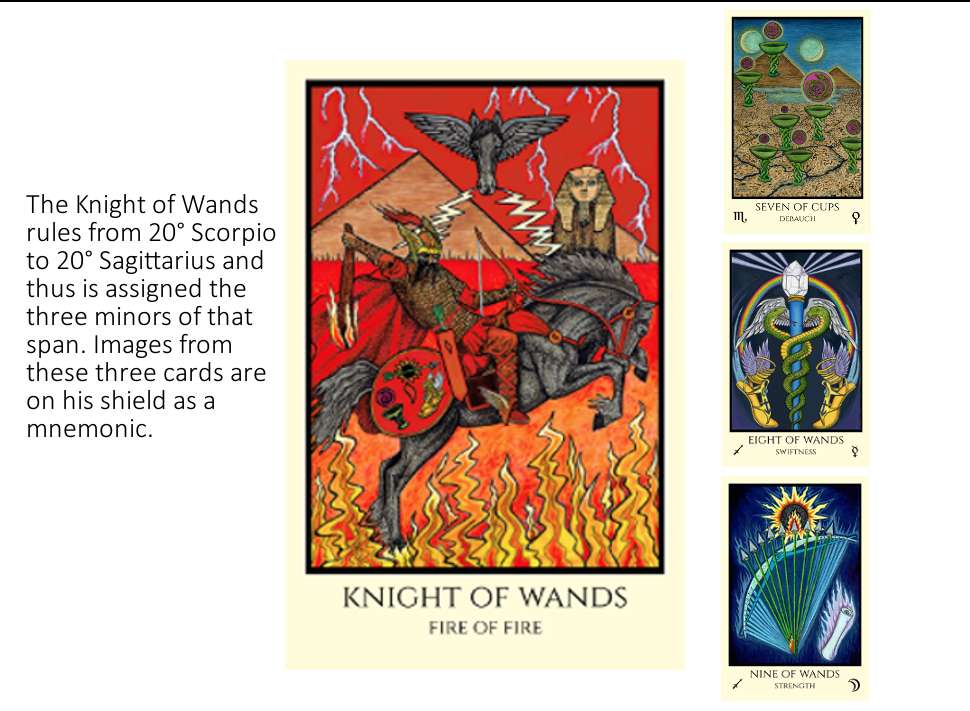
What does the Knight of Wands mean? (Thoth based decks) Or, what does the King of Wands mean? (RWS based decks)
The Knight of Wands, also known as the King of Wands, is an older or well-established man. As Fire of Fire, he has a combustible nature, making him impulsive and proud, swift to take action but without endurance. He can be lucky; his first shot can be very successful! But if not, he lacks follow through and hates to do anything twice. At worst he can be unpredictable, intolerant of other opinions, and cruel.
With the Eight of Wands, Swiftness and the Nine of Wands, Strength he is inspired and has the will to win and hit his target. Yet in times of stress, he may wallow in the delusionary aspects of the Seven of Cups, Debauch/Illusionary Success.
- If the Knight of Wands or King of Wands relates to a situation rather than a person, it usually is an opportunity arising to do your will, a “flash-in-the-pan” that comes up unexpectedly and swiftly, yet moves along quickly as well.
correspondences of the knight of wands
| Lord of the Flame and the Lightning, King of the Spirits of Fire, King of the Salamanders |
| Court crest: winged black horse head |
| Regalia and symbols: Black horse. Waving flames. Winged helmet. Scarlet cloak and large club. |
| Fire of Fire |
| [20° – 29° Scorpio III, Fixed Water], 0° – 19° Sagittarius I & II, Mutable Fire |
| Star group: Sagittarius, Ophiuchus, Hercules, Draco |
| Related Majors: [Death], Art/Temperance |
| Related Minors: (7 of Cups), 8 of Wands, 9 of Wands |
| I-Ching Hexagram 51: Thunder (Arousing) |
| Geomantic figure: Acquisitio |
What does the Queen of Wands mean?

The Queen of Wands is a mature and regal woman who is generous, warm, and wields command and authority with composure. She is capable and adaptable, resolved and courageous with much inner power. She has considerable magnetism and is often successful in business. The lower qualities of the Queen of Wands are impatience, obstinacy, and vengeful intolerance of those who defy her will.
The Two of Wands, Dominion, shows her determination and will as well as leadership abilities. The Three of Wands, Virtue/Established Strength, gives her creative force and the trails of good governance. Her shadow decan, the Ten of Cups, Satiety/Perfected Success, shows her secret desire for oblivion and loss of control.
- If the Queen of Wands relates to a situation rather than a person, it can refer to qualities of inner fire and Shakti power.
correspondences of the Queen of Wands
| The Queen of the Thrones of Flame, Queen of the Salamanders |
| Court crest: Winged leopard head |
| Regalia and symbols: Leopard. Wand with heavy conical head. Flame throne. Steady flames. |
| Water of Fire |
| [20° – 29° Pisces III, Mutable Water], 0° – 19° Aries I & II, Cardinal Fire |
| Star group: Pisces, Aries, Andromeda, Cassiopeia |
| Related Majors: [The Moon], The Emperor |
| Related Minors: (10 of Cups), 2 of Wands, 3 of Wands |
| I-Ching Hexagram 17: Following |
| Geomantic figure: Puer |
What does the Prince of Wands mean? (Or, what does the Knight of Wands mean, when using RWS based decks.)

Usually, the Prince of Wands is a younger man or youth, who is generous and proud, romantic and vital. He may like drama and attention, or just be charismatic with a lust for life. He is generally upright and honorable, but sometimes acts first before thinking things through. At worst the Prince of Wands can be contentious, self-aggrandizing, “full of hot air”, or lazy and self-centered.
He fluctuates between Strife (Five of Wands) and Victory (Six of Wands). His shadow card is the Four of Cups, Luxury/Blended Pleasure, which shows his pleasure-seeking nature and his attraction to emotional highs.
- When the Prince of Wands refers to a situation rather than a person, it can indicate a time when one is striving for success – or basking in it as the center of attention.
Correspondences of the Prince of Wands
| The Prince of the Chariot of Fire, Prince and Emperor of the Salamanders |
| Court crest: Winged lion head |
| Regalia and symbols: Fire Wand of Zelator Adeptus Minor. Lion chariot. Waved and salient flames. |
| Air of Fire |
| [20° – 29° Cancer III, Cardinal Water], 0° – 19° Leo I & II, Fixed Fire |
| Star group: Leo, Leo Minor, Ursa Minor, Southern Dog. Includes Regulus, Royal Watcher of the North |
| Related Majors: [The Chariot], Lust/Strength |
| Related Minors: (Four of Cups), 5 of Wands, 6 of Wands |
| I Ching Hexagram 42: Increasing |
| Geomantic figure: Fortuna Major |
What does the Princess of Wands mean? Or, what does the Page of Wands mean? (RWS based decks)
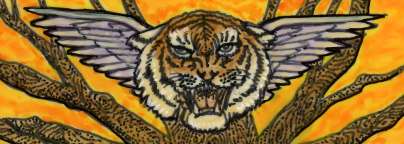
The Princess of Wands or Page of Wands is a young woman or child, usually female, who is a force of nature – a daring and energetic “hot tamale” that is compelled to blaze – it is hard to look away. The Princess or Page of Wands is magnetic, fervent, and full of ardor and intensity. At her worst she can be shallow, unsympathetic, unreliable, capricious, and melodramatic. In her full flowering, she wields the wand and the power “To Will” – which is consistent with her central sign of Leo, whose motto is “I will”.
- If the Princess of Wands appears as a situation rather than as a person, it can indicate the start and/or fruition of a spontaneous creative outpouring or passion project, and suddenly arising volatile desires.
Correspondences of Princess of Wands or Page of Wands
| The Princess of the Shining Flames, the Rose of the Palace of Fire, Throne of the Ace of Wands, Princess and Empress of Salamanders |
| Court crest: Winged tiger head |
| Regalia and symbols: Golden fire altar. Long club, heavier at the end. Leaping flames. |
| Earth of Fire |
| Cancer-Leo-Virgo quadrant – area of Asia |
| Related Majors: The Chariot, Lust/Strength, The Hermit |
| Related Minor: Ace of Wands |
| I-Ching Hexagram 27 Nourishment (Jaws) |
| Geomantic Figure: Cauda Draconis |
What does the Knight of Cups mean? (Thoth based decks) Or, what does the King of Cups mean? (RWS based decks)
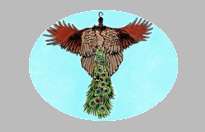
The Knight of Cups, also known as the King of Cups, is an older or mature man of established position who is sensitive and imaginative, amiable, inspired, and graceful. It is not difficult to arouse him to emotional interest, yet he can lack sustained feeling.
If the Knight of Cups type yields to his otherworldly and overly passive side, Indolence (Eight of Cups) causes him to abandon his goals, But, when he follows his creative impulses, Happiness (Nine of Cups) and wish fulfillment results. His hidden decan is the Seven of Swords, Futility/Unstable Effort, which indicates a deceptive tendency and deficient character that tends towards escapism.
- When the Knight of Cups (King of Cups) appears as a situation rather than a person, there can be artistic inspiration, mystical pursuits and purpose, transcendence, or a “Holy Grail” type of quest arising.
Correspondences of the Knight of Cups or King of Cups
| Lord of the Waves and the Waters, King of the Hosts of the Sea, King of Undines and Nymphs |
| Court crest: Peacock with open wings |
| Regalia and symbols: White horse, the sea, crab issuing from a cup |
| Fire of Water |
| [20° – 29° Aquarius III, Fixed Air], 0° – 19° Pisces I & II, Mutable Water |
| Star group: Pegasus, The Square, Cepheus |
| Related Majors: [The Star], The Moon |
| Related Minors: (7 of Swords), 8 of Cups, 9 of Cups |
| I-Ching Hexagram 54: Marrying Maiden |
| Geomantic figure: Laetitia |
What does the Queen of Cups mean?
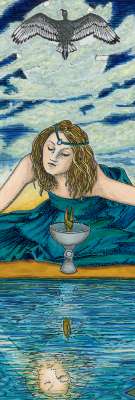
The Queen of Cups is a mature and intuitive woman who is placid and tranquil, and has a dreamy and imaginative nature. She is emotional and nurturing, maternal, and protective of her family. She is sensitive and psychic, guided by her own depths. As Water of Water, the Queen of Cups takes on forms, dissolves boundaries, and reflects back what is unconscious in those before her. Sometimes she is moody and overly needy, and she can be susceptible to unwise influences.
Her highest qualities are reflected in the Two of Cups, Love, and the Three of Cups, Abundance. Her shadow decan is the Ten of Swords, Ruin – which can indicate the disruptive mental forces that sometimes afflict her judgement.
- If the Queen of Cups relates to a situation rather than a person, it can refer to a time when intuition, dreams, memories, and prophecies can appear, or a time of inner emotional reflection or nurturing arises.
Correspondences of the Queen of Cups
| The Queen of the Thrones of the Waters, Queen of Nymphs and Undines |
| Court crest: Ibis with open wings |
| Regalia and symbols: Crayfish issuing from cup, lotus, reflective water, flowing water |
| Water of Water |
| [20° – 29° Gemini III, Mutable Air], 0° – 19° Cancer I & II, Cardinal Water |
| Star group: Castor/Pollux (Gemini III), Praesepe/Manger, Canis Minor, Argo Navis, Ursa Minor |
| Related Majors: [The Lovers], The Chariot |
| Related Minors: (10 of Swords), 2 of Cups, 3 of Cups |
| I-Ching Hexagram 58: Lake (Joyous) |
| Geomantic figure: Populus |
What does the Prince of Cups mean? (Or, what does the Knight of Cups mean, when using RWS based decks.)

Usually, the Prince of Cups is a younger man or youth, who hides his inner nature. He is secretive about his interests, devotions, and motivations, and puts forth a calm exterior to hide a ruthless and passionate inner disposition. He is driven and intense and desires power of all types. At worst, the Prince of Cups can be wily and lacking in conscience. He holds a grudge and will stop at nothing when it comes to revenge.
With the Five and Six of Cups as his primary decan cards, he swings between extremes of Disappointment/Loss in Pleasure and Pleasure. His shadow card, the Four of Swords, Truce/Rest from Strife, is a place he only gets to when fully emotionally exhausted from alternating gratification and pathos.
- When the Prince of Cups refers to a situation rather than a person, there can be an encounter with secrets and the desire nature, jealously or passive aggression, and the heights and depths with which one will go to pursue the object of fascination.
Correspondences of the Prince of Cups
| The Prince of the Chariot of the Waters, Prince and Emperor of Nymphs and Undines |
| Court crest: Eagle |
| Regalia and symbols: Scorpion, chariot pulled by eagle, serpent issuing from cup, lotus, lake |
| Air of Water |
| [20° – 29° Libra III, Cardinal Air], 0° – 19° Scorpio I & II, Fixed Water |
| Star group: Scorpion, Serpens, Lupus. Includes Antares, Royal Watcher of the West |
| Related Majors: [Adjustment/Justice], Death |
| Related Minors: (4 of Swords), 5 of Cups, 6 of Cups |
| I-Ching Hexagram 61: Sincerity |
| Geomantic figure: Rubeus |
What does the Princess of Cups mean? Or, what does the Page of Cups mean? (RWS based decks)
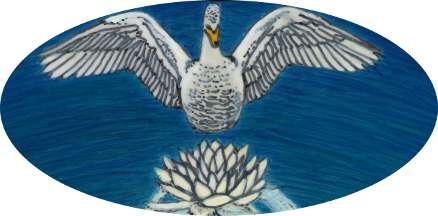
The Princess of Cups, also known as the Page of Cups, is a young woman or child, usually female, who embodies the qualities of calm water – soothing, cooling, and gentle. She has a tender heart and is devotional and emotional. The Princess of Cups or Page of Cups makes a great helper, often working behind the scenes without taking credit. At her worst, she can be deceitful, self-absorbed, and overly reliant on others. In her full flowering, she offers the cup and wields the power “To Dare” also known as to Love – which is how she achieves the purpose of her central sign of Scorpio, whose motto is “I desire”.
- When the Princess of Cups appears as a situation rather than as a person, there can be a longing for divine union, devotion or soul merging, the appearance of a muse or helper, or a wish to be rescued.
Correspondences of Princess of Cups or Page of Cups
| The Princess of the Waters, the Lotus of the Palace of Water, Throne of the Ace of Cups. Princess and Empress of the Nymphs and Undines |
| Court crest: Swan with open wings |
| Regalia and symbols: Dolphin, Lotus, Turtle issuing from cup, sea spray |
| Earth of Water |
| Libra-Scorpio-Sagittarius quadrant – area of the Pacific |
| Related Majors: Adjustment/Justice, Death, Art/Temperance |
| Related Minor: Ace of Cups |
| I-Ching Hexagram 41: Decreasing |
| Geomantic figure: Via |
What does the Knight of Swords mean? (Thoth based decks) Or, what does the King of Swords mean? (RWS based decks)
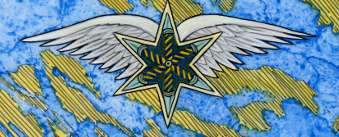
The Knight of Swords, also known as the King of Swords, is an older or mature man of established position who is active, intellectual, gifted with words, and very rational. Yet he can be restless and changeable. At worst, the Knight or King of Swords is prone to expend too much energy in trivial pursuits, and to have a cutting and callous nature. These traits are shown by the cards of the Knight of Swords’ main decans.
The Eight of Swords, Interference/Shortened Force, indicates how he may spread himself thin or apply his efforts unproductively. The Nine of Swords, Cruelty and Despair, shows his potential for thoughtless brutality and acerbic remarks. His shadow card, the Seven of Disks, Failure/Success Unfulfilled, is something he has a horror of and thus tries to over zealously circumvent.
- When the Knight of Swords (King of Swords) appears as a situation rather than a person, storm and activity arise and rational analysis and discrimination are paramount, decisions are to be made, and words can be used with brilliance or to wound.
Correspondences of the Knight of Swords or King of Swords
| Lord of the Winds and the Breezes, King of the Spirits of Air, King of the Sylphs and Sylphides |
| Court Crest: Winged six-pointed star |
| Regalia and symbols: Brown horse, drawn sword, driving stratus clouds |
| Fire of Air |
| [20° – 29° Taurus III, Fixed Earth], 0° – 19° Gemini I & II, Mutable Air |
| Star group: Castor and Pollux, Auriga, Canis Major and Minor |
| Related Majors: [The Hierophant], The Lovers |
| Related Minors: (7 of Disks), 8 of Swords, 9 of Swords |
| I-Ching Hexagram 32: Enduring |
| Geomantic figure: Albus |
What does the Queen of Swords mean?

The Queen of Swords is a mature and sharp woman who has a clear mind and is very clever and perceptive. She is independent and can even represent the divorced woman or widow. The Queen of Swords is intelligent – she brooks no argument and does not suffer fools gladly. She is graceful and makes an excellent dance partner; she is fair and observant and makes an exceptional witness. At worst the Queen of Swords can be emasculating, severe, dictatorial, superficial, sly, and willing to use charm in a deceitful way.
The Two of Swords, Peace/Peace Restored, shows her mental flexibility in the face of dualities. The Three of Swords, Sorrow, brings enlightenment even if painful and isolating. Her shadow card the Ten of Disks, Wealth, shows where she can get stuck: becoming micro-managing in her pursuit of ultimate perfection.
- If the Queen of Swords relates to a situation rather than a person, it is time to perceive patterns, get insight, sharpen skills, and get clear on what you need; but more importantly, to get clarity about what you don’t need so it can be cut away without pity in order to liberate your mind.
Correspondences of the Queen of Swords
| The Queen of the Thrones of Air, Queen of Sylphs and Sylphides |
| Court crest: Winged child head |
| Regalia and symbols: Severed head of a bearded man, drawn sword, grey cumulous clouds |
| Water of Air |
| [20° – 29° Virgo III, Mutable Earth], 0° – 19° Libra I & II, Cardinal Air |
| Star group: The Scales, Hydra, Bootes, Corona, Crux |
| Related Majors: [The Hermit], Adjustment/Justice |
| Related Minors: (10 of Disks), 2 of Swords, 3 of Swords |
| I-Ching Hexagram 28: Great, Exceeding |
| Geomantic Figure: Puella |
What does the Prince of Swords mean? (Or, what does the Knight of Swords mean, when using RWS based decks.)

Usually, the Prince of Swords is a younger man, or youth, who is rational and brilliant, humane, inventive, and idealistic of nature. As Air of Air, he is good with words and with thinking. He makes a lot of plans and is capable of coming up with viable and intelligent alternatives in any situation. The Prince of Swords has a breadth of ideas and is good at thought experiments – but he has so many ideas he can be erratic and fail to hold on to his many innovations. He often plays “devil’s advocate” and is fond of debate for the sake of being contrary. His bad traits are rigidity, zealous attraction to movements, and being overly passive in situations where he should go on the offense.
The Five of Swords, Defeat, shows his pacifism almost to a fault. The Six of Swords, Science/Earned Success, shows his originality and ingenious gift for improvisation. His shadow card, the Four of Disks, Power/Earthly Power, shows that in times of exhaustion he can become rigid and unyielding.
- When the Prince of Swords refers to a situation rather than a person, there can be innovations, technical solutions, conversations or a chance to debate, and many thoughts or ideas coming through the aethers simultaneously.
Correspondences of the Prince of Swords
| The Prince of the Chariot of the Winds, Prince and Emperor of Sylphs and Sylphides |
| Court crest: Winged angelic head with a pentagram on the brow |
| Regalia and symbols: chariot pulled by winged arch-fey, drawn sword and sickle, whorled armor, dark nimbus clouds |
| Air of Air |
| [20° – 29° Capricorn III, Cardinal Earth], 0° – 19° Aquarius I & II, Fixed Air |
| Star group: Aquarius, Southern Fish, Dolphin, Swan. Includes Fomalhaut, Royal Watcher of the South |
| Related Majors: [The Devil], The Star |
| Related Minors: (4 of Disks), 5 of Swords, 6 of Swords |
| I-Ching Hexagram 57: Wind, Gently Penetrating |
| Geomantic figure: Tristitia |
What does the Princess of Swords mean? Or, what does the Page of Swords mean? (RWS based decks)
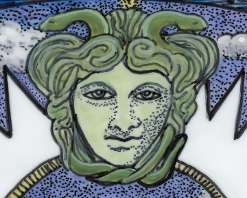
The Princess of Swords, also known as the Page of Swords, is a young woman or a child, usually female, who battles the forces of illusion and strives for clarity of mind. She is stern, resolved, strategic, purposeful and sometimes avenging. She is active and decisive. The Princess of Swords is capable of bridging the astral and material worlds, meaning she can bring things from the mind to life. That’s the definition of magick! At her worst, she stirs up conflict and is volatile and underhanded. In her full flowering, she grasps the sword and wields the power “To Know” – which is in accordance with her central sign of Aquarius, whose motto is “I know”.
- When the Princess of Swords appears as a situation rather than as a person, there can be a chance to avenge wrongs, clear the air or get clarity, exercise mind over matter, or a time to be alert and skillfully take action to bring an idea to manifestation.
Correspondences of Princess of Swords or Page of Swords
| The Princess of the Rushing Winds, the Lotus of the Palace of Air, Throne of the Ace of Swords, Princess and Empress of the Sylphs and Sylphides |
| Court crest: Medusa head |
| Regalia and symbols: Smoking silver altar, drawn sword, white cirrus clouds |
| Earth of Air |
| Capricorn-Aquarius-Pisces quadrant – area of the Americas |
| Related Majors: The Devil, The Star, The Moon |
| Related Minor: Ace of Swords |
| I-Ching Hexagram 18: Remedying |
| Geomantic figure: Fortuna Minor |
What does the Knight of Disks mean? (Thoth based decks) Or, what does the King of Pentacles mean? (RWS based decks)
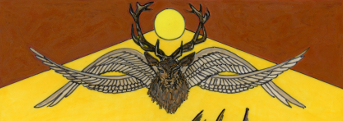
The Knight of Disks, also known as the King of Pentacles, is an older or mature man of established position and a taciturn nature who is practical, patient, persevering, and hard working. As a result he has enduring energy for steady progress towards material goals, and is good at accountancy and shepherding resources. He may have an interest in food production. His negative qualities make him stolid, dour, and dull at times, as well as fault-finding, sullen, and resentful of the successes of those with quicker natures.
The Eight of Disks, Prudence, shows how his patience and attention to detail yields the fruits of the Nine of Disks, Gain/Material Gain. His shadow card, the Seven of Wands, Valour, shows that he may yearn to boldly go on the offensive; yet his way is through quiet and diligent effort
- When the Knight of Disks (King of Pentacles) appears as a situation rather than a person, there may be harvests or a need for attention to detail and patient cultivation of your resources projects without rushing them along.
Correspondences of the Knight of Disks or King of Disks
| Lord of the Wide and Fertile Land, King of the Spirits of Earth, King of Gnomes |
| Court crest: Winged stag head |
| Regalia and symbols: Light brown horse, field of ripe corn, scepter with hexagram, pentacle of Zelator Adeptus Minor |
| Fire of Earth |
| [20° – 29° Leo III, Fixed Fire], 0° – 19° Virgo I & II, Mutable Earth |
| Star group: Astraea/Virgin, Spica, Hunting Dogs, Crater, Corvus |
| Related Majors: [Lust/Strength], The Hermit |
| Related Minors: (7 of Wands), 8 of Disks, 9 of Disks |
| I-Ching Hexagram 62: Exceeding |
| Geomantic figure: Conjunctio |
What does the Queen of Disks mean? Or, what does the Queen of Pentacles mean?

The Queen of Disks, also known as the Queen of Pentacles, is a mature and realistic woman of businesslike acumen with a great capacity for work. As a result she is ambitious and disciplined, cautious with resources and somewhat conservative. But the Queen of Disks or Queen of Pentacles is down to earth and large of heart, a salt-of-the-earth type who is sensible, fertile, and sensual. Usually she is dignified, but at her worst she can be vulgar and bawdy, with a tendency to addiction to drugs, alcohol, or pleasures of the senses. She can also be a material climber.
The Two of Disks, Change/Harmonious Change, shows her patience necessary cycles of business expansion and contraction that overall lead to growth. The Three of Disks, Work/Works, show how she utilizes everything at her command to construct something of substance. Her shadow card is the Ten of Wands, Oppression, betraying that a tendency to tyranny may be her undoing.
- If the Queen of Disks or Queen of Pentacles relates to a situation rather than a person, it can signify that is time of steady competence when you can use your practical skills to grow and build something in the material world, using all resources at your disposal.
Correspondences of the Queen of Disks or Pentacles
| The Queen of the Thrones of Earth, Queen of Gnomes |
| Court crest: Winged goat heat |
| Regalia and symbols: profile lit on one side, scepter with cube, orb of gold, desert lands |
| Water of Earth |
| [20° – 29° Sagittarius III, Mutable Fire], 0° – 19° Capricorn I & II, Cardinal Earth |
| Star group: Capricorn, Lyra, Aquila, Sagitta |
| Related Majors: [Art/Temperance], The Devil |
| Related Minors: (10 of Wands), 2 of Disks, 3 of Disks |
| I-Ching Hexagram 31: Influence (Attraction) |
| Geomantic figure: Carcer |
What does the Prince of Disks mean? (Or, what does the Knight of Pentacles mean, when using RWS based decks.)


Usually, the Prince of Disks, also known as the Knight of Pentacles, is a younger man or youth, who is grounded and steady, reliable, tactile, cautious, and not easily provoked. He is a fine judge of quality, and applies himself to material concerns to grow resources. His lower qualities tend towards a having a plodding nature as well as stubbornness, greed, and sloth. He has indifference towards and dismissal of anything he considers impractical or outside his area of interest.
He swings between the extremes of the Five of Disks, Worry/Material Worry and the Six of Disks, Success/Material Success, placing much importance on the latter. His shadow card, the Four of Wands, Completion/Perfected Work shows that while he worries and strives for complete material success, there is no benefit to obtaining supposed perfection, as it is his very efforts that benefit him.
- When the Prince of Disks or Knight of Pentacles refers to a situation rather than a person, it is a time of sowing seeds to increase your resources, attending to business, working steadily, and doing practical things like maintenance, chores, and bookkeeping, to prevent worry and bring success.
Correspondences of the Prince of Disks or Knight of Pentacles
| The Prince of the Chariot of Earth, Prince and Emperor of Gnomes |
| Court crest: Winged bull head |
| Regalia and symbols: chariot drawn by bull, land with many flowers, orb of gold held downwards, scepter with orb and cross |
| Air of Earth |
| [20° – 29° Aries III, Cardinal Fire], 0° – 19° Taurus I & II, Fixed Earth |
| Star group: Taurus, Perseus, Throne of Cassiopeia, Eridanus. Includes Aldebaran, Royal Watcher of the East |
| Related Majors: [The Emperor], The Hierophant |
| Related Minors: (4 of Wands), 5 of Disks, 6 of Disks |
| I-Ching Hexagram 53: Developing Gradually |
What does the Princess of Disks mean or what does the Page of Pentacles mean?

The Princess of Disks, also known as the Page of Disks, is a young woman or a child, usually female, who is strong and grounded, patient, brave, inwardly composed and quiet, industrious, protective, and maternal. She is kind and generous and capable of deep loyalty. She is “pregnant with possibility” for this card is both a culmination and a renewal. At her worst, she is erratic and unstable, wastes resources and her full potential, and does things to excess. In her full flowering, she grasps the disk and wields the power “To Keep Silent” and take action, ultimately “To Go”. The motto of her central sign Taurus, is “I have”, showing her full range of potentiality.
- If the Princess of Disks refers to a situation rather than a person, it is the time to take action upon fertile grounds laid and bring something to a full stage of completion, or something is already complete and ready for succession.
Correspondences of the Princess of Disks or Pentacles
| The Princess of the Echoing Hills, the Rose of the Palace of Earth, Throne of the Ace of Disks, Princess and Empress of Gnomes |
| Court crest: Winged ram head |
| Regalia and symbols: Sheepskin mantle, carries a pentacle similar to Ace of Disks/Pentacles, scepter with circular disk, grove |
| Earth of Earth |
| Aries-Taurus-Gemini quadrant – area of Europe and Africa |
| Related Majors: The Emperor, The Hierophant, The Lovers |
| Related Minor: Ace of Disks |
| I-Ching Hexagram 52: Mountain (Stillness) |
| Geomantic figure: Caput Draconis |
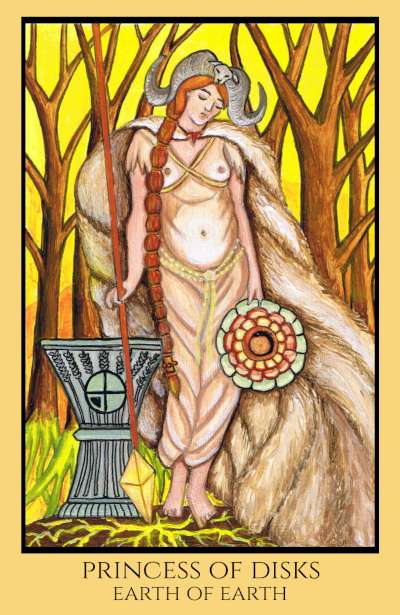
But you lose the court card as a possible draw when you use it as a Tarot significator?
Yes, when you use a court card or other tarot card as a significator that does obviously eliminate that card as coming up in the reading. The theory is that it places the card as you, in the reading. If losing the possibility of that card coming up bothers you, both Rosetta Tarot and Tabula Mundi Tarot have a solution. Rosetta Tarot comes with a card that has a cartouche where the querent’s name can be written in hieroglyphs. Tabula Mundi Tarot comes with an expansion pack that contains astrologically decan-based cards that can be used as significators for people or situations. Both the large and mid-size decks have the expansion pack available.
Whether choosing a tarot significator, deciding who a court card represents, or deciphering the meaning of the tarot court cards in a reading, they have a lot of personality and a lot to offer!


